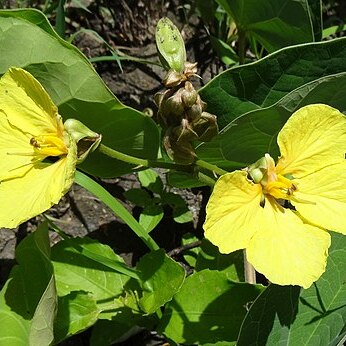Shrub with a large or very large (> 80 kg), woody, perennial tuber from which several annual stems arise; proximal part of stems woody; prostrate and trailing or climbing, up to 6 m long; young parts rusty tomentose or rusty pubescent, indumentum becoming greyish or ± disappearing. Tendrils axillary, forked, 40-80 mm long, lateral branches 10-20 mm long. Leaves alternate, simple, palmately veined with 7-11 main veins; lamina shallowly bilobed apically to about one tenth to one third (very rarely to half) of length of leaf lobes, deeply cordate basally, broadly circular, 60-110(-200) x 50-120(-180) mm, usually rusty pubescent below, sometimes subglabrous or densely tomentose, slightly folded along median main vein, lobes ovate-oval to obovate; petiole 30-70 mm long. Stipules ±2-4 x 2 mm, persistent. Racemes solitary and terminal on sympodial branching, 3-10-flow-ered; peduncle (20-)50-175 mm long; axis (20-)50-230(-400) mm long. Flowers bisexual, irregular, medium to small, yellow. Hypanthium 3-8 mm long, lightly sulcate outside. Sepals 5, upper two completely or partly fused, other three free, 10-15 x 3-4 mm, ± conspicuously keeled along back. Petals 5, yellow, fading to pink; upper one (vexillum) smaller than the rest and bicallose basally, the four larger ones obovate to obovate-suborbicular, crinkled-bullate, 20-40 x 10-30 mm, tapering into basal claw. Stamens 2, fertile, remaining 7 or 8 staminodial, unequal, 3-6 mm long; filaments of fertile stamens 6-10 mm long; anthers dorsifixed. Pistil superior, long-stipitate, glabrous; gynophore 10-15 mm long, adnate to inside of hypanthium; ovary 1-loculed, 5-6 mm long, 2-or 3(4)-ovuled; style elongate, 4-8 mm long; stigma very small, not wider than top of style. Pod woody, dehiscent or (rarely) indehiscent, obovate to oblong-ovate, oval to circular when containing only 1 seed, 50-100 x 30-60 mm, 1 or 2(3)-seeded. Seed large, oblate, seed coat chestnut-brown to black, with a U-shaped line extending for a short distance from hilum, suborbicular or ellipsoid, 15-28 x 10-20 mm, funicle short.
More
Stems prostrate and trailing or climbing up to 6 m or more, herbaceous or woody below; young parts rusty-tomentose or rusty-pubescent, indumentum becoming greyish or ± disappearing. Tenrils forked, 4-8 cm long, the lateral branched 1-2 cm long. Leaves: petiole 3-7 cm long (in our area); blade 6-11(20) cm long, 5-12(18) cm wide usually ± rusty-pubescent beneath especially on nerves, sometimes subglabrous or densely tomentose, shallowly bilobed apically to about one-tenth to one-third(very rarely to half) the length of the leaf from the lobe-ends to junction with petiole, deeply cordate basally; lobes ovate-oval to obovate. Stipules 2-4 mm long, ±2 mm broad. Racemes: peduncle (2)5-17.5 cm long; axis (2)5-23 (40) cm long; pedicels (1.5)2-6 cm long. Hypanthium 3-8 mm long. Sepals 1-1.5 cm long, 3-4 mm wide, ± conspicuously keeled along back, the upper two fused, the other three free. Petals yellow, fading to pink; the four larger ones obovate to obovate-suborbicular, crinkled-bullate, 2-4 cm long, 1-3 cm wide, tapering into a basal claw. Stamens: filaments of fertile stamens 8-10 mm long, of staminodes 3-6 mm long. Ovary 5-6 mm long, pubescent. Pod obovate to oblong-ovate, 5-10 cm long, 3-6 cm wide. Seeds suborbicular or ellipsoid, 1.5-2.8 cm long, 1-2 cm wide, chestnut-brown to blackish.
A trailing or climbing plant. It is evergreen and shrubby. It can be 6 m long. It has a large tuberous root. This can be to a depth of 2.5 m. Young plant parts have rusty coloured hairs. The leaves are simple and almost round but with two lobes or divided at the tip. Leaves are 5-20 cm long by 6-23 cm wide. There are rusty hairs on the veins underneath the leaf. The flower clusters are 2-42 cm long on stalks 2-17 cm long. The flowers have 5 petals. Four of these are yellow and one is reduced to a green stub. The petals are yellow. The outer layer or sepals have wings. Fruit are 7-12 cm long and 4-7 cm wide. The seeds are not quite round and are 1.7-2.8 cm long.
Woody climber. Leaf lobes 60-200 mm long, leaves divided apically for a tenth to a third of their length, base deeply cordate, petiole 30-70 mm long. Flowers yellow.
It is a tropical plant. It does well in seasonally wet and dry climates. It needs well-drained soil. In Malawi it grows at 900-1,200 m altitude. In Tanzania it grows up to 1,500 m above sea level and in areas with a rainfall between 1,000-1,600 mm. It needs full sun. It can grow in arid places. It suits hardiness zones 9-12.

